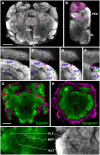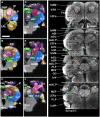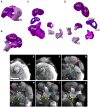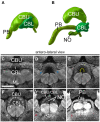A map of brain neuropils and fiber systems in the ant Cardiocondyla obscurior
- PMID: 25698935
- PMCID: PMC4316776
- DOI: 10.3389/fnana.2014.00166
A map of brain neuropils and fiber systems in the ant Cardiocondyla obscurior
Abstract
A wide spectrum of occupied ecological niches and spectacular morphological adaptations make social insects a prime object for comparative neuroanatomical studies. Eusocial insects have evolved complex societies based on caste polyphenism. A diverse behavioral repertoire of morphologically distinct castes of the same species requires a high degree of plasticity in the central nervous system. We have analyzed the central brain neuropils and fiber tract systems of the worker of the ant Cardiocondyla obscurior, a model for the study of social traits. Our analysis is based on whole mount preparations of adult brains labeled with an antibody against Drosophila-Synapsin, which cross-reacts strongly with synapses in Cardiocondyla. Neuropil compartments stand out as domains with a certain texture and intensity of the anti-Synapsin signal. By contrast, fiber tracts, which are composed of bundles of axons accompanied by glia and are devoid of synapses, appear as channels or sheaths with low anti-Synapsin signal. We have generated a digital 3D atlas of the Cardiocondyla brain neuropil. The atlas provides a reference for future studies of brain polymorphisms in distinct castes, brain development or localization of neurotransmitter systems.
Keywords: Cardiocondyla obscurior; fiber tracts; hymenoptera; neuroanatomy; neuropile compartements.
Figures






Similar articles
-
Sphingolipids, Transcription Factors, and Conserved Toolkit Genes: Developmental Plasticity in the Ant Cardiocondyla obscurior.Mol Biol Evol. 2015 Jun;32(6):1474-86. doi: 10.1093/molbev/msv039. Epub 2015 Feb 27. Mol Biol Evol. 2015. PMID: 25725431 Free PMC article.
-
Interruption points in the wing gene regulatory network underlying wing polyphenism evolved independently in male and female morphs in Cardiocondyla ants.J Exp Zool B Mol Dev Evol. 2019 Jan;332(1-2):7-16. doi: 10.1002/jez.b.22834. Epub 2018 Nov 20. J Exp Zool B Mol Dev Evol. 2019. PMID: 30460750
-
Causes and consequences of a complex recombinational landscape in the ant Cardiocondyla obscurior.Genome Res. 2024 Jul 23;34(6):863-876. doi: 10.1101/gr.278392.123. Genome Res. 2024. PMID: 38839375 Free PMC article.
-
Fitness and aging in Cardiocondyla obscurior ant queens.Curr Opin Insect Sci. 2016 Aug;16:58-63. doi: 10.1016/j.cois.2016.05.010. Epub 2016 May 18. Curr Opin Insect Sci. 2016. PMID: 27720051 Review.
-
Life-history evolution in ants: the case of Cardiocondyla.Proc Biol Sci. 2017 Mar 15;284(1850):20161406. doi: 10.1098/rspb.2016.1406. Proc Biol Sci. 2017. PMID: 28298341 Free PMC article. Review.
Cited by
-
A Statistically Representative Atlas for Mapping Neuronal Circuits in the Drosophila Adult Brain.Front Neuroinform. 2018 Mar 23;12:13. doi: 10.3389/fninf.2018.00013. eCollection 2018. Front Neuroinform. 2018. PMID: 29628885 Free PMC article.
-
Brain Organization of Apolygus lucorum: A Hemipteran Species With Prominent Antennal Lobes.Front Neuroanat. 2019 Jul 17;13:70. doi: 10.3389/fnana.2019.00070. eCollection 2019. Front Neuroanat. 2019. PMID: 31379518 Free PMC article.
-
Anatomical organization of the cerebrum of the desert locust Schistocerca gregaria.Cell Tissue Res. 2018 Oct;374(1):39-62. doi: 10.1007/s00441-018-2844-8. Epub 2018 May 9. Cell Tissue Res. 2018. PMID: 29744590
-
Functional brain regeneration in the acoel worm Symsagittifera roscoffensis.Biol Open. 2015 Nov 18;4(12):1688-95. doi: 10.1242/bio.014266. Biol Open. 2015. PMID: 26581588 Free PMC article.
-
Lineages to circuits: the developmental and evolutionary architecture of information channels into the central complex.J Comp Physiol A Neuroethol Sens Neural Behav Physiol. 2023 Jul;209(4):679-720. doi: 10.1007/s00359-023-01616-y. Epub 2023 Mar 17. J Comp Physiol A Neuroethol Sens Neural Behav Physiol. 2023. PMID: 36932234 Free PMC article. Review.
References
Grants and funding
LinkOut - more resources
Full Text Sources
Other Literature Sources

